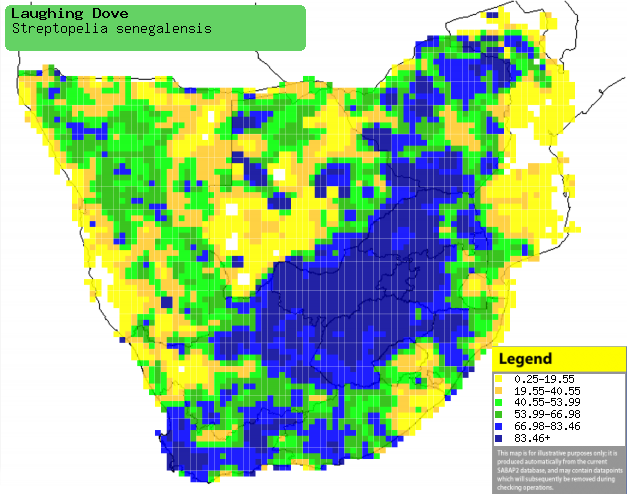Streptopelia senegalensis (Laughing
Dove)
Rooiborsduifie [Afrikaans]; Icelekwane, Uvelemaxhoseni
[Xhosa]; uKhonzane [Zulu]; Hamanku/Katere [Kwangali]; Leebana-khoroana (also
applied to Red-eyed dove and Cape turtle-dove), Mphubetsoana [South Sotho];
Njiva (also applied to Cape turtle dove) [Shona]; Lituba (also applied to
Laughing dove) [Swazi]; Gugurhwana [Tsonga]; Lephôi, Tsôkwane [Tswana];
Palmtortel [Dutch]; Tourterelle maillée [French]; Senegaltaube, Palmtaube
[German]; Rola do Senegal [Portuguese]
Life
> Eukaryotes >
Opisthokonta
> Metazoa (animals) >
Bilateria >
Deuterostomia > Chordata >
Craniata > Vertebrata (vertebrates) > Gnathostomata (jawed
vertebrates) > Teleostomi (teleost fish) > Osteichthyes (bony fish) > Class:
Sarcopterygii (lobe-finned
fish) > Stegocephalia (terrestrial
vertebrates) > Tetrapoda
(four-legged vertebrates) > Reptiliomorpha > Amniota >
Reptilia (reptiles) >
Romeriida > Diapsida > Archosauromorpha > Archosauria >
Dinosauria
(dinosaurs) > Saurischia > Theropoda (bipedal predatory dinosaurs) >
Coelurosauria > Maniraptora > Aves
(birds) > Order: Columbiformes > Family:
Columbidae > Streptopelia
The Laughing dove is abundant in southern Africa, as it is
found everywhere except coastal Mozambique. It has benefited greatly from
habitat disturbance by humans, and is found in all types of woodlands, as well as
suburban parks and gardens. It mainly eats seeds, with fruits, bulbs and nectar
making up the rest of its diet. The female normally makes its own nest, while
the male collects material. It lays 1-6, usually 2 eggs, which are incubated by
both sexes, for 12-14 days, after which the chicks hatch. They leave the nest at
12-13 days old, before they have even learnt to fly. At 3-4 days after leaving
the nest, they fledge, after which they become fully independent.
Distribution and habitat
Occurs across sub-Saharan Africa, largely excluding Gabon,
southern Cameroon and central DRC. In southern Africa it is extremely common and
widespread, occupying woodland, farmland, suburban parks, Acacia plantations and gardens.
|
 |
|
Distribution of Laughing dove in southern Africa,
based on statistical smoothing of the records from first SA Bird Atlas
Project (©
Animal Demography unit, University of
Cape Town; smoothing by Birgit Erni and Francesca Little). Colours range
from dark blue (most common) through to yellow (least common).
See here for the latest distribution
from the SABAP2. |
Predators and parasites
- Predators
- of adults
- of eggs
- of chicks
Food
Eats mainly seeds, as well as small fruit, bulbs and insects,
doing most of its foraging on the ground. The following food
items have been recorded in its diet.
- Plants
- seeds:
- grasses
- Eleusine
- Panicum
- Poa
- Setaria
- Urochloa
- sedges
- trees and shrubs
- Atriplex
- Amaranthus
- Chenopodium
- Cleome
- Commelina
- Croton
- Cucumis
- Hibiscus
- Malva
- Osteospermum
- Oxalis
- Physalis
- Rhus
- Solanum
- Sphalmanthus
- Talinum
- Tetragonia
- Ulmus (alien elm)
- Acacia cyclops (Rooikrans)
- Acacia saligna (Port Jackson Willow)
- seeds crushed by passing traffics
- Eucalyptus camaldulensis (Red river gum)
- Ficus natalensis (Coastal strangler fig)
- commercial crops
- sorghum
- maize
- oats
- sunflowers
- wheat
- acorns of Quercus robur (Common oak)
- fruit
- Atriplex semibaccata (Creeping saltbush)
- Ficus sycomore (Sycomore fig)
- Rhus (Currants)
- Salvadora persica (Mustard-tree)
- Flueggea virosa (Wart-stem whiteberry-bush)
- nectar of Aloe marlothii (Mountain Aloe)
- bulbs of sedges
- Invertebrates
-
termites
- ants
- Musca domestica (House fly) larvae and pupa
- snails
Breeding
- It normally makes its own nest in about two days, with the
male collecting material which the female incorporates into the nest. The nest is a frail
bowl of twigs and leaves, 8-14 cm wide, lined with fine material such
as rootlets. It is typically placed in a fork in a tree, which is
often an alien. It also uses nest of other birds, such as
Cape Turtle Dove,
Kurrichane
thrush, Olive thrush and
Cape Sparrow.
 |
|
|
Laughing dove at its nest in hose coil, Modimolle,
South Africa. [photo Warwick Tarboton ©] |
|
- Egg-laying season is year-round, peaking from August-December.
- It lays 1-6, usually 2 eggs, which are incubated by both sexes for 12-14
days. The parents change shifts twice daily: the female incubates in the
night, and the male takes the day shift
- The chicks are fed frequently for the first week of their lives, 1-4
times per hour, after which they are fed 0-2 times an hour. For the first
three
days they are fed only crop milk, after which they are fed a mixture of
small and large seeds.
- The nestlings remain in the nest for 12-13 days. Three to four days before
they have learnt to fly, they leave the nest for the surrounding bush.
Leaving the nest before being able to fly is why people mistakenly rescue
chicks that seem to have 'fallen out of the nest'. If a chick is in a
vulnerable position, (e.g. a cat is eyeing it), it is best to remove the
danger or to position it in a safer place, but it is not advisable to take
it away from its parents.
Threats
Not threatened, in fact extremely common, as it has
benefited greatly from habitat disturbance and changes in land use.
References
-
Hockey PAR, Dean WRJ and Ryan PG 2005. Roberts
- Birds of southern Africa, VIIth ed. The Trustees of the John Voelcker
Bird Book Fund, Cape Town.
|
